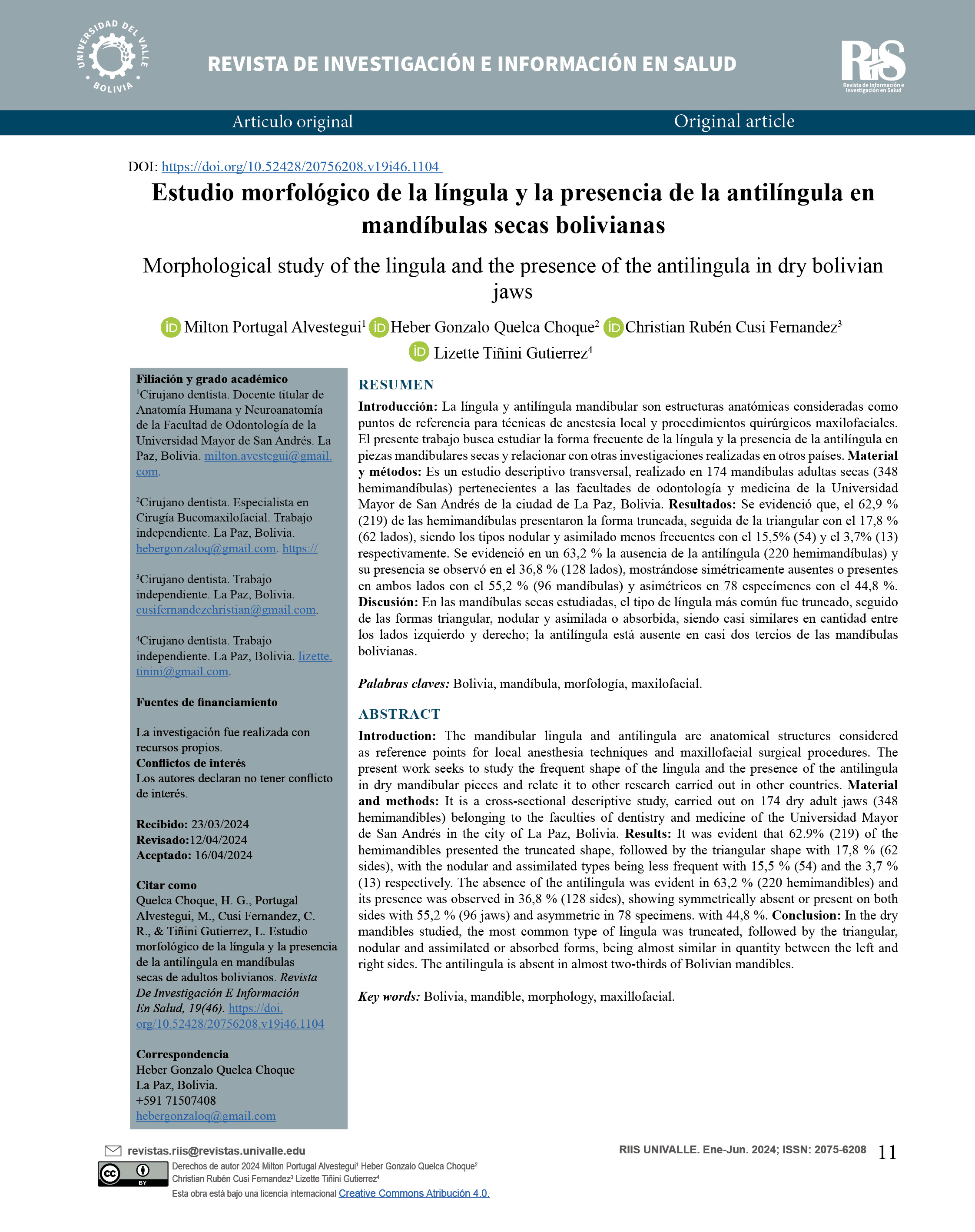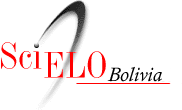Morphological study of the lingula and the presence of the antilingula in dry mandibles of Bolivian adults
DOI:
https://doi.org/10.52428/20756208.v19i46.1104Keywords:
Lingula, antilingula, mandible, morphology.Abstract
The mandibular lingula and antilingula are anatomical structures considered as reference points for local anesthesia techniques and maxillofacial surgical procedures. The present work seeks to study the frequent shape of the lingula and the presence of the antilingula in dry mandibular pieces and relate it to other research carried out in other countries. It is a cross-sectional descriptive study, carried out on 174 dry adult jaws (348 hemimandibles) belonging to the faculties of dentistry and medicine of the Universidad Mayor de San Andrés in the city of La Paz, Bolivia. The results showed that 62.9% (219) of the hemimandibles presented the truncated shape, followed by the triangular shape with 17.8% (62 sides), with the nodular and assimilated types being less frequent with 15.5% (54) and 3.7% (13) respectively. The absence of the antilingula was evident in 63.2% (220 hemimandibles) and its presence was observed in 36.8% (128 sides), showing symmetrically absent or present on both sides with 55.2% (96 jaws) and asymmetric in 78 specimens. . with 44.8%. We conclude that, in the dry mandibles studied, the most common type of lingula was truncated, followed by the triangular, nodular and assimilated or absorbed forms, finding a relationship with the data found in Thailand and Brazil. No significant differences were found in the types of mandibular lingula between the left and right sides. The antilingula is absent in almost two-thirds of Bolivian mandibles.
Downloads
References
- Moore KL, Dalley AF, Agur AM. Anatomía de orientación clínica. 8ª ed. Barcelona: Wolters Kluwer; 2017.
- Rouviere H, Delmas A. Anatomía Humana descriptiva, topográfica y funcional. 11ª ed. Barcelona: Masson; 2005.
- Testud L, Jacob O. Anatomía Topográfica. 8ª ed. Barcelona: Salvat;1927.
- Figun M, Garino R. Anatomía odontológica funcional y aplicada. 3° ed. Buenos Aires: El Ateneo; 2020
- He P, Iwanaga J, Matsushita Y, Adeeb N, Topale N, Tubbs RS, et al. A Una revisión comparativa de las cirugías ortognáticas mandibulares con el enfoque en la osteotomía intraoral vertico-sagital de la rama [Internet]. 2017; 9 (12). Available from: https://pubmed.ncbi.nlm.nih.gov/32760640/
Tuli A, Choudhry R, Choudhry S, Raheja S, Agarwal S. Variación de la forma anatómica de la língula en mandíbulas adultas. J Anat. 2000; 197: 313-7. Available from: https://www.ncbi.nlm.nih.gov/pmc/articles/PMC1468130/
https://doi.org/10.1046/j.1469-7580.2000.19720313.x DOI: https://doi.org/10.1046/j.1469-7580.2000.19720313.x
PMid:11005723 PMCid:PMC1468130
- Kositbowornchai S, Siritapetawee M, Damrongrungruang T, Khongkankong W, Chatrchaiwiwatana S, Khamanarong K, et al. Forma de la língula y su localización por radiografía panorámica vs medición en mandíbulas secas. Surg Radiol Anat. 2007;29(8): 689-694. Available from: https://link.springer.com/article/10.1007/s00276-007-0270-9
https://doi.org/10.1007/s00276-007-0270-9 DOI: https://doi.org/10.1007/s00276-007-0270-9
PMid:17960323
- Jansisyanont P, Apinhasmit W, Chompoopong S. Forma, altura y ubicación de la língula para la osteotomía sagital de la rama en Tailandia. Clin Anat. 2009;22(7). Available from: https://onlinelibrary.wiley.com/doi/10.1002/ca.20849
- Murlimanju BV, Prabhu LV, Pai MM, Paul MT, Saralaya VV, Kumar CG. Estudio morfológico de la língula de las mandíbulas en la población del sur de la India. Morphologie. 2012; 96 (312): 16-20. Available from: https://www.sciencedirect.com/science/article/abs/pii/S1286011512000021?via%3Dihub
https://doi.org/10.1016/j.morpho.2012.01.001 DOI: https://doi.org/10.1016/j.morpho.2012.01.001
PMid:22445529
- Alves N, Deana NF. Morphological study of the lingula in adult human mandibles of Brazilians individuals and clinical implications. Biomed Res Int; 2015: 1-7. Available from: https://pubmed.ncbi.nlm.nih.gov/25821826/
https://doi.org/10.1155/2015/873751 DOI: https://doi.org/10.1155/2015/873751
PMid:25821826 PMCid:PMC4363710
- Asdullah M, Ansari AA, Khan MH, Salati NA, Khawja KJ, Sachdev AS. Variaciones morfológicas de la língula y prevalencia de agujeros mandibulares accesorios: un estudio. Cirugía Natl J Maxillofac. 2018; 9 (2): 129-133. Available from: https://www.ncbi.nlm.nih.gov/pmc/articles/PMC6251292/
https://doi.org/10.4103/njms.NJMS_13_16 DOI: https://doi.org/10.4103/njms.NJMS_13_16
PMid:30546225 PMCid:PMC6251292

Published
How to Cite
Issue
Section
License
Copyright (c) 2024 Heber Gonzalo Quelca Choque, Milton Portugal Alvestegui, Christian Ruben Cusi Fernandez, Lizette Tiñini Gutierrez

This work is licensed under a Creative Commons Attribution 4.0 International License.
Authors who publish with this journal agree to the following terms:
- Authors retain copyright and grant the journal right of first publication with the work simultaneously licensed under a Creative Commons Attribution License 4.0 that allows others to share the work with an acknowledgement of the work's authorship and initial publication in this journal.
- Authors are able to enter into separate, additional contractual arrangements for the non-exclusive distribution of the journal's published version of the work (e.g., post it to an institutional repository or publish it in a book), with an acknowledgement of its initial publication in this journal.
- Authors are permitted and encouraged to post their work online (e.g., in institutional repositories or on their website) prior to and during the submission process, as it can lead to productive exchanges, as well as earlier and greater citation of published work.






















